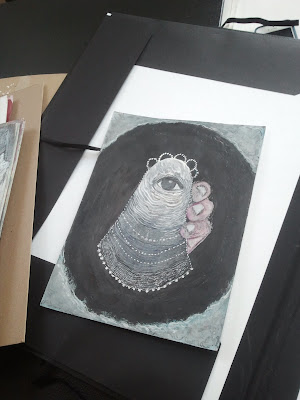ROYA FARASSAT: THE MIRROR HAS TWO FACES
The paintings that fill Roya Farassat’s solo exhibition “A Mirror with Two Faces” present a variety of symbolic portraits that reflect the repressive social conditions in her homeland of Iran and the psychological repercussions that have resulted from them. What begins as a form of social critique gives way to a pantheon of ciphers and phantoms that are iconic and pathetic, expressive and opaque. We can view them alternately as a reflection of ourselves, or of a world in which we do not belong.
Though they at first seem to resemble one another, subtle differences emerge from these images, which in their degree of symbolism are similar to ghost portraits popular during the Victorian era, or effigies constructed to perform rituals of vengeance. They are small in scale, creating an intimate viewing experience, like looking at family photographs. In truth, we are observing one large aspect of the psychological family of man, in which the various states of emotional existence are broadly manifested. They can be said to separate into certain classifications: a demonized woman in a veil, gesturing and peering down a street; a manifest embodiment of self-consciousness marred to paranoia, symbolized by a body with no head but only one large eye, like the searchlight atop a lighthouse, blankly surveying everything within its optical territory; and characters that resemble effigies or totems, creatures of darkness who emerge out of the dark recesses a primordial past, to take on the fears Farassat depicts; which in being hers, are ours as well. Who has not seen a creature in their dreams, a demon at the gate, or under a bridge, exacting a psychic price for the rigor of wisdom?
Farassat’s exhibition is a hall of mirror that reflects what is inside of us. They are a pantheon of gods and demons, but they are also pieces of humanity, each one a minute reflection of where a repressed society, constantly imposing a status quo value system while denying each of its members the freedom to express themselves idiosyncratically as members of a race, a nation, a community, and as individuals. The loss of the chance for progressive socialization within the community and individuation within the self. Of course, these are modern ideas which a democratic society takes easily for granted. Given that Farassat’s background denied her access to modernity, it makes perfect sense that her images would express a grotesque sensibility. Surrounded by a veiled populace, wondering at their motives and their possible actions, Farassat has been prompted to symbolize this state of emotional siege rather merely describe it. Her work allows us to understand what it means to be blindly accused and confront the appearance of our accusers, seeing them while at the same time being seen.



Comments